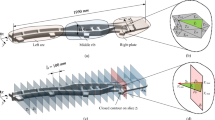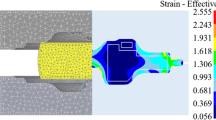Abstract
The performance and service life of aeroengine forgings, vital components of aeroengines, are profoundly impacted by their forming quality, which is substantially influenced by deformation uniformity. This study aims to control the deformation uniformity of thin-walled conical aeroengine forgings through preform design. Initially, the DEFORM DOE (design of experiments) module and MATLAB are utilized to simulate various scenarios, automatically acquiring samples with preform die geometry parameters as variables. Subsequently, a deformation uniformity prediction model is constructed by integrating genetic algorithm (GA) and support vector regression (SVR). The fitness function of the genetic algorithm is defined as the mean squared error (MSE) between the predicted values of the SVR model and the finite element simulation values, iteratively optimizing the SVR model. The results reveal that the established prediction model, based on limited sample data, achieves high accuracy and efficiency, significantly diminishing the frequency of trial-and-error simulations while enhancing the efficiency of preform design for thin-walled conical forgings. Finite element simulation outcomes and macro/microstructure test results following trial production further validate the deformation uniformity prediction model’s exceptional accuracy.













Similar content being viewed by others
Data availability
Not applicable.
References
Han Y, Wang M, Chen Y, Chen M, Xiang X (2023) Automatic preform design and optimization for aeroengine disk forgings. Int J Adv Manuf Technol 125(3–4):1845–1858. https://doi.org/10.1007/s00170-022-10627-z
Wei K, Zhan M, Fan X (2018) Unequal-thickness billet optimization in transitional region during isothermal local loading forming of Ti-alloy rib-web component using response surface method. Chinese J Aeronaut 31(4):845–859. https://doi.org/10.1016/j.cja.2017.07.005
Langner J, Stonis M, Behrens B (2016) Investigation of a moveable flash gap in hot forging. J Mater Process Tech 231:199–208. https://doi.org/10.1016/j.jmatprotec.2015.12.019
Yang Y, Liu D, He Z, Luo Z (2010) Optimization of preform shapes by RSM and FEM to improve deformation uniformity in aerospace forgings. Chinese J Aeronaut 23(2):260–267. https://doi.org/10.1016/S1000-9361(09)60214-4
Gao P, Fei M, Yan X, Wang S, Li Y, Xing L, Wei K, Zhan M, Zhou Z, Keyim Z (2019) Prediction of the folding defect in die forging: a versatile approach for three typical types of folding defects. J Manuf Process 39:181–191. https://doi.org/10.1016/j.jmapro.2019.02.027
Chan WL, Fu M, Lu J, Chan L (2009) Simulation-enabled study of folding defect formation and avoidance in axisymmetrical flanged components. J Mater Process Tech 209(11):5077–5086. https://doi.org/10.1016/j.jmatprotec.2009.02.005
Li F, Chen P, Han J, Deng L, Yi J, Liu Y, Eckert J (2020) Metal flow behavior of P/M connecting rod preform in flashless forging based on isothermal compression and numerical simulation. J Market Res 9(2):1200–1209. https://doi.org/10.1016/j.jmrt.2019.11.047
Torabi S, Alibabaei S, Bonab B, Sadeghi M, Faraji G (2017) Design and optimization of turbine blade preform forging using RSM and NSGA II. J Intell Manuf 28(6):1409–1419. https://doi.org/10.1007/s10845-015-1058-0
Kong T, Chan L, Lee T (2008) Numerical and experimental investigation of preform design in non-axisymmetric warm forming. Int J Adv Manuf Technol 37(9–10):908–919. https://doi.org/10.1007/s00170-007-1036-6
Kim N, Kobayashi S (1990) Preform design in H-shaped cross sectional axisymmetric forging by the finite element method. Int J Mach Tool Manu 30(2):243–268. https://doi.org/10.1016/0890-6955(90)90134-5
Kang B, Lee J, Kim B, Choi J (1995) Process design in flashless forging of rib/web-shaped plane-strain components by the finite element method. J Mater Process Tech 47(3):291–309. https://doi.org/10.1016/0924-0136(95)85005-8
Tao Y, Zhou J, Cao J, Cao J, Luo Y, Chen B (2015) Optimization design preform billet shape of 7050 aluminum alloy giant plane forgings based on electric field method and MBC toolbox. Int J Adv Manuf Technol 81(1–4):231–240. https://doi.org/10.1007/s00170-015-7149-4
Guan Y, Bai X, Liu M, Song L, Zhao G (2015) Preform design in forging process of complex parts by using quasi-equipotential field and response surface methods. Int J Adv Manuf Technol 79(1–4):21–29. https://doi.org/10.1007/s00170-014-6775-6
Yang H, Ma X, Jiao F, Zheng F (2019) Preform optimal design of H-shaped forging based on bi-directional evolutionary structural optimization. Int J Adv Manuf Technol 101(1–4):1–8. https://doi.org/10.1007/s00170-018-2906-9
Shao Y, Lu B, Xu DK (2016) Topology-based preform design optimization for blade forging. Int J Adv Manuf Technol 86(5–8):1593–1605. https://doi.org/10.1007/s00170-015-8263-z
Shao Y, Lu B, Ou H, Chen J (2015) A new approach of preform design for forging of 3D blade based on evolutionary structural optimization. Struct Multidiscipl Optim 51(1):199–211. https://doi.org/10.1007/s00158-014-1110-2
Zhao G, Zhao Z, Wang T, Grandhi RV (1998) Preform design of a generic turbine disk forging process. J Mater Process Technol 84(13):193–201. https://doi.org/10.1016/S0924-0136(98)00221-0
Liu C, Xu W, Wang Y, Liu M (2021) Optimal design of preform shape based on EFA-FEM-GA integrated methodology. Int J Mater Form 14(5):1043–1056. https://doi.org/10.1007/s12289-021-01620-0
Zhang D, Yang H (2013) Preform design for large-scale bulkhead of TA15 titanium alloy based on local loading features. Int J Adv Manuf Technol 67(9–12):2551–2562. https://doi.org/10.1007/s00170-012-4673-3
Meng F, Cai Z, Chen Q (2019) Multi-objective optimization of preforming operation in near-net shape forming of complex forging. Int J Adv Manuf Technol 105(10):4359–4371. https://doi.org/10.1007/s00170-019-04539-8
Alimirzaloo V, Biglari FR, Sadeghi MH et al (2019) A novel method for preform die design in forging process of an airfoil blade based on Lagrange interpolation and meta-heuristic algorithm. Int J Adv Manuf Technol 102(9–12):4031–4045. https://doi.org/10.1007/s00170-019-03512-9
Lee S, Quagliato L, Park D, Kwon I, Sun J, Kim N (2021) A new approach to preform design in metal forging processes based on the convolution neural network. App Sci 11(17):7948. https://doi.org/10.3390/app11177948
Cao Z, Xia J, Zhang M, Jin J, Deng L, Wang X, Qu J (2015) Optimization of gear blank preforms based on a new R-GPLVM model utilizing GA-ELM. Knowl-Based Syst 83:66–80. https://doi.org/10.1016/j.knosys.2015.03.010
Mahesh B (2020) Machine learning algorithms -a review. Int J Life Sci Pharm 9:381–386. https://doi.org/10.21275/ART20203995
Roy A, Chakraborty S (2023) Support vector machine in structural reliability analysis: a review. Reliab Eng Syst Safe 233:109126. https://doi.org/10.1016/j.ress.2023.109126
Basudhar A, Missoum S (2008) Adaptive explicit decision functions for probabilistic design and optimization using support vector machines. Comput Struct 86(19–20):1904–1917. https://doi.org/10.1016/j.compstruc.2008.02.008
Wang X, Huang Z, Cai B, Zhou N, Magdysyuk O, Gao Y, Srivatsa S, Tan L, Jiang L (2019) Formation mechanism of abnormally large grains in a polycrystalline nickel-based superalloy during heat treatment processing[J]. Acta Mater 168:287–298. https://doi.org/10.1016/j.actamat.2019.02.012
Géron A (2022) Hands-on machine learning with Scikit-Learn, Keras, and TensorFlow. O'Reilly Media, Inc., Sebastopol, CA
Mirjalili S (2019) Genetic algorithm. In: Evolutionary algorithms and neural networks. Studies in Computational Intelligence, vol 780. Springer, Cham. https://doi.org/10.1007/978-3-319-93025-1_4
Funding
This research is supported by the Guizhou Science and Technology Cooperation Support Project (2021) General 308 and the Green Manufacturing System Integration Project of the Ministry of Industry and Information Technology (Grant No: 2018272106).
Author information
Authors and Affiliations
Contributions
Menghan Wang conceived and designed the experiments. Yan Han and Tao Guo performed the experiments. MengLong Du analyzed the data. Menghan Wang and Yan Han wrote the paper.
Corresponding author
Ethics declarations
Consent to participate
All authors agreed with the consent to participate.
Consent for publication
All authors have read and agreed to the published version of the manuscript.
Competing interests
The authors declare no competing interests.
Additional information
Publisher's Note
Springer Nature remains neutral with regard to jurisdictional claims in published maps and institutional affiliations.
Rights and permissions
Springer Nature or its licensor (e.g. a society or other partner) holds exclusive rights to this article under a publishing agreement with the author(s) or other rightsholder(s); author self-archiving of the accepted manuscript version of this article is solely governed by the terms of such publishing agreement and applicable law.
About this article
Cite this article
Han, Y., Wang, M., Du, M. et al. Research on deformation uniformity control of thin-walled conical aeroengine forgings based on GA-SVR. Int J Adv Manuf Technol 131, 1211–1222 (2024). https://doi.org/10.1007/s00170-024-13156-z
Received:
Accepted:
Published:
Issue Date:
DOI: https://doi.org/10.1007/s00170-024-13156-z




